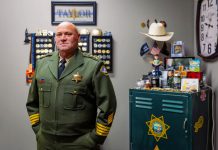In Toledo it was always The Fight
It was held on a blistering July 4, 1919 at Bay View Park. Not a
breeze from Lake Erie stirred the entire day while thousands of
spectators gasped for air and bought ladles of water that vendors
sold from tin pails. Several dozen people fainted with the
temperature edging past 110 degrees.
In Toledo it was always The Fight
It was held on a blistering July 4, 1919 at Bay View Park. Not a breeze from Lake Erie stirred the entire day while thousands of spectators gasped for air and bought ladles of water that vendors sold from tin pails. Several dozen people fainted with the temperature edging past 110 degrees.
It differed from many similar July days because it was the one on which Jack Dempsey became the world’s heavyweight champion by pounding Jess Willard into senselessness.
Through the 1940s many local businesses still sported murals of a crouching Dempsey ready to unleash himself again on the stunned Willard, fallen against the ropes with arms thrust through them.
Willard was the favorite but some followers of boxing were putting wagers on Dempsey. Willard at 6-foot-6 towered five inches over his opponent and at 245 pounds outweighed him by 55 pounds.
When the opening gong sounded the champion brought the crowd to its feet by throwing a hard punch at Dempsey, then suddenly Willard was down, the first time ever in his career. He shook his head and got up, then a few seconds later was down again.
When he arose, another flurry of brutal punches sent him to the canvas again and the spectators at ringside screamed for the fight to be stopped. Before the end of the first round, Dempsey had knocked Willard down seven times.
The fight was stopped after round three. Willard’s jaw was broken as were a cheekbone and two ribs. His right eye was swollen shut, he had lost two teeth and was covered with blood.
Dempsey’s subsequent career was spectacular. He knocked out some of the world’s best boxers, and after being beaten by Gene Tunney got a rematch, which many felt he should have won. He knocked Tunney down but did not go to a neutral corner, a new rule, and the referee’s count did not begin until he did. Many spectators maintained that Tunney took 14 seconds to get up, the infamous long count.
He served as a commander in the Coast Guard in World War II and later wrote a book on the science of boxing.
A legend current when I was a boy said that if someone went into Dempsey’s restaurant and said he was from Toledo, he could have anything on the menu free. Even as gullible as I was I didn’t believe that. In 1953 when I was 19 and living in Manhattan I had dinner there one evening. A stir arose in the front and I looked up to see the man himself going through the restaurant shaking hands. When he came to my table I arose and said, “Mr. Dempsey, I’ve already paid for my meal but want to tell you that the folks in Toledo still talk about your fight there.”
He smiled and said, “It’s always good to see someone from Toledo,” and stuck out his hand.
His grip was like iron.









